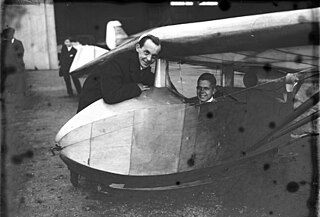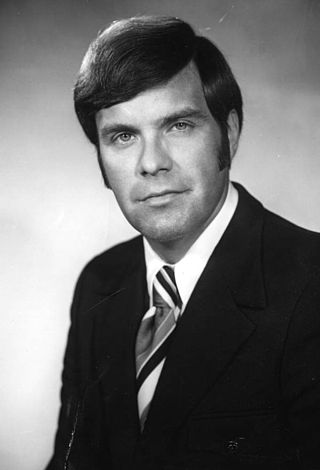Related Research Articles
The Curtiss-Wright Corporation is a manufacturer and services provider headquartered in Davidson, North Carolina, with factories and operations in and outside the United States. Created in 1929 from the consolidation of Curtiss, Wright, and various supplier companies, the company was immediately the country's largest aviation firm and built more than 142,000 aircraft engines for the U.S. military during World War II. Today, it no longer makes aircraft but makes many related components, particularly actuators, aircraft controls, valves, and surface-treatment services. It also supplies the commercial, industrial, defense, and energy markets; it makes parts for commercial and naval nuclear power systems, industrial vehicles, and oil- and gas-related machinery.

Glenn Hammond Curtiss was an American aviation and motorcycling pioneer, and a founder of the U.S. aircraft industry. He began his career as a bicycle racer and builder before moving on to motorcycles. As early as 1904, he began to manufacture engines for airships. In 1908, Curtiss joined the Aerial Experiment Association, a pioneering research group, founded by Alexander Graham Bell at Beinn Bhreagh, Nova Scotia, to build flying machines.

Alexander Martin Lippisch was a German aeronautical engineer, a pioneer of aerodynamics who made important contributions to the understanding of tailless aircraft, delta wings and the ground effect, and also worked in the U.S. Within the Opel-RAK program, he was the designer of the world's first rocket-powered glider.

The Etrich Taube, also known by the names of the various later manufacturers who built versions of the type, such as the Rumpler Taube, was a pre-World War I monoplane aircraft. It was the first military aeroplane to be mass-produced in Germany.

Donald Wills Douglas Sr. was an American aircraft industrialist and engineer.

Daytona Beach International Airport is a county-owned airport located three miles (5 km) southwest of Daytona Beach, next to Daytona International Speedway, in Volusia County, Florida, United States. The airport has 3 runways, a six-gate domestic terminal, and an international terminal. Daytona Beach is the headquarters of Embry-Riddle Aeronautical University.

The Goodyear Blimp is any one of a fleet of airships operated by the Goodyear Tire and Rubber Company, used mainly for advertising purposes and capturing aerial views of live sporting events for television. The term blimp itself is defined as a non-rigid airship—without any internal structure, the pressure of lifting gas within the airship envelope maintains the vessel's shape.

The Martin Mace was a ground-launched cruise missile developed from the earlier Martin TM-61 Matador. It used a new self-contained navigation system that eliminated the need to get updates from ground-based radio stations, and thereby allowed it to fly further beyond the front lines. To take advantage of this longer practical range, Mace was larger than Matador and could travel a longer total distance.

The Daytona Beach News-Journal is a Florida daily newspaper serving Volusia and Flagler Counties.
The Wyndham Championship is a professional golf tournament in North Carolina on the PGA Tour. It is played annually in Greensboro and was originally the Greater Greensboro Open.
The Azalea Open Invitational was a golf tournament in North Carolina on the PGA Tour, held at Cape Fear Country Club in Wilmington. Last played in November 1971 as an unofficial event; it was an official PGA Tour event in 1945 and from 1949 through 1970. The Heritage in South Carolina debuted in 1969 and soon displaced it on the schedule.
The Goodall Palm Beach Robin Robin was a golf tournament on the PGA Tour from 1938 to 1957. It was also known as the Goodall Robin Robin and the Palm Beach Robin Robin. The sponsors were the Goodall Company and its subsidiary, the Palm Beach Clothing Co. The purse for the tournament was $5,000, with $1,000 going to the winner, from 1938 to 1941, increased to $10,000/$2,000 in 1946, and increased again to $15,000/$3,000 in 1949. Sam Snead won the event five times including both the first and last events.

Ralph H. Haben, Jr. is an American attorney, lobbyist, and politician who served as the Speaker of the Florida House of Representatives from 1980 to 1982. Haben graduated from the University of Florida in 1964 and Cumberland School of Law in 1967, and began working as a government prosecutor, first for the city of Palmetto, Florida and then for the Twelfth Judicial Circuit Court of Florida. He eventually became a judge before running for the Florida House of Representatives in 1972. In the House, he served on numerous committees, including the Criminal Justice Committee, and eventually became Speaker. He left the legislature to run for Florida Comptroller in 1982, but lost the only election in his electoral history. He briefly considered a run for Governor of Florida, but decided instead to become a lobbyist for many large interests in the state legislature.
The Triangle Round Robin was a golf tournament on the LPGA Tour from 1953 to 1962. It was played at several different courses on the East Coast of the United States.

Thomas W. Benoist was an American aviator and aircraft manufacturer. In an aviation career of only ten years, he formed the world's first aircraft parts distribution company, established one of the leading early American aircraft manufacturing companies and a successful flying school, and from January to April 1914 operated the world's first scheduled airline.

Emil Matthew Laird was a pioneering American aircraft designer, builder, pilot, and businessman. He put the first commercial aircraft into production at his E. M. Laird Aviation Company.
The Babcock Airplane Corporation was a short-lived aviation company from 1939 to 1945, located in DeLand, Florida.
Pro-Composites, Inc is an American aircraft manufacturer based in Buffalo Grove, Illinois. The company is owned by Scott VanderVeen and specializes in the design and manufacture of aircraft design plans, parts and kits for amateur construction.
Eyerly Aircraft Company was an amusement ride manufacturing company in Salem, Oregon, founded by Lee Eyerly in 1930. The company originally intended to design flight simulators for the aircraft industry but shifted to amusement rides after an early simulator, called Orientator, became a popular pay-per-ride attraction with the public. The company manufactured rides until 1985 and went bankrupt in 1990, following a fatal accident in 1988 on a ride built by the company.
Dwane Leon Wallace was an American aviation businessman and aircraft designer. He served as the president and/or chairman of the board of the Cessna Aircraft Company from 1935 until the 1970s, having then continued on the board as a director and consultant into the 1980s. Wallace later became known as the "Quiet Giant of Aviation", and was posthumously inducted into the National Aviation Hall of Fame in 2012. He was included in the Flying Magazine list of the "51 Heroes of Aviation", placing at number 11.
References
- 1 2 3 4 5 "Babcock LC-13A Taube".
- ↑ http://www.ancestry.com/1940-census/usa/Florida/Vearne-C-Babcock_4l2pfn Social Security Administration records indicate, however, that he was an Ohio native, born 28 April 1887, and his number, 298-01-7439, carried the Ohio prefix. [ user-generated source ]
- ↑ "SortedByName.com — B". Archived from the original on 23 June 2015. Retrieved 23 June 2015.
- ↑ Philadelphia, Pennsylvania, The Times, Tuesday 22 October 1901, page 12.
- ↑ Associated Press, "Crimean's Good Race. Made Saint Louis Cracks Look Cheap In Sprint Races", The Buffalo Express, Buffalo, New York, Friday 6 June 1902, page 11.
- ↑ Buffalo Morning Express
- 1 2 3 4 Chapter VIII. The Last Pathfinder
- ↑ Norris, Max, "Pilots And Planes Were Even - Neither Knew How To Fly", The Daytona Beach Morning Journal, Daytona Beach, Florida, Saturday 31 May 1958, Volume XXXIII, Number 130, page 3.
- ↑ "Daytona Beach Morning Journal - Google News Archive Search".
- 1 2 3 St. Petersburg, Florida, "Airplane Factory Will Move Here on Sept. 15: Babcock Corporation Will Occupy Old Gospel Tabernacle Building", St. Petersburg Times, Sunday 8 September 1940, Volume 57, Number 43, The Sunday Special, page 4.
- ↑ Wheat, George Seay, "The Story of the American Legion", The Knickerbocker Press, G. P. Putnam's Sons, New York, London, 1919, page 264.
- ↑ Wheat, George Seay (1919). The Story of the American Legion. G. P. Putnam's sons. p. 264.
vearne c. babcock.
- ↑ Image McBride Bill
- ↑ Gunston, Bill (1993). World Encyclopedia of Aircraft Manufacturers. Annapolis: Naval Institute Press.
- ↑ "American airplanes: Ta - Th". www.aerofiles.com. Retrieved 16 March 2023.
- ↑ "VEARNE C BABCOCK - THE BEACON MICROPHONE COMPANY - Business Profiles".
- ↑ "THE BEACON MICROPHONE COMPANY Ohio - Business Profiles" . Retrieved 16 March 2023.
- ↑ "THE BEACON MICROPHONE COMPANY :: Ohio (US) :: OpenCorporates".
- ↑ St. Petersburg, Florida, "Airplane Factory Will Move Here on Sept. 15: Babcock Corporation Will Occupy Old Gospel Tabernacle Building", St. Petersburg Times, Sunday 8 September 1940, Volume 57, Number 43, The Sunday Special, page 1.
- ↑ Daytona Beach, Florida, "New Airplane Plant Officially Opened In DeLand", The Dayton Beach Morning Journal, Tuesday 11 June 1940, Volume XVI, Number 181, page 9.
- ↑ National Register of Historic Places Registration Form, NPS Form 10-900, National Park Service, 29 June 2009.
- ↑ "Archived copy" (PDF). Archived from the original (PDF) on 23 June 2015. Retrieved 23 June 2015.
{{cite web}}: CS1 maint: archived copy as title (link) - ↑ Andrade, John M., "U.S. Military Aircraft Designations and Serials since 1909", Midland Counties Publications, Earl Shilton, Leister, UK, 1979, ISBN 0-904597-22-9, p. 96.
- ↑ "Warbirds and Airshows". WWII Glider Manufacturing Sties and Output. Retrieved 16 March 2023.
- ↑ "Boat hull".
- ↑ Library of Congress, Catalog Office, "Catalog of Copyright Entries. Third Series: 1954: July–December", 27 August 1954, A150609, page 924.
- ↑ "Catalog of Copyright Entries. Third Series: 1954: July-December". 1955.
- ↑ "Verna Babcock - Ancestry.com". www.ancestry.ca. Retrieved 16 March 2023.